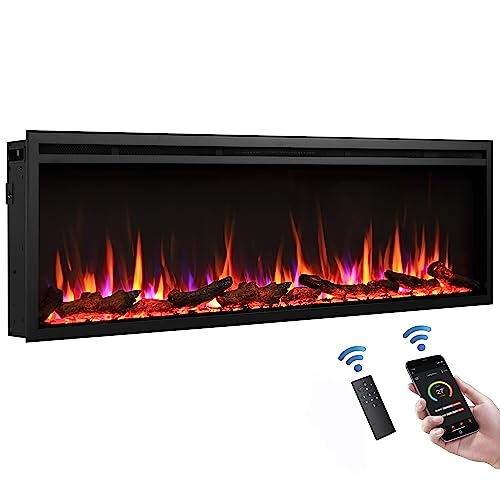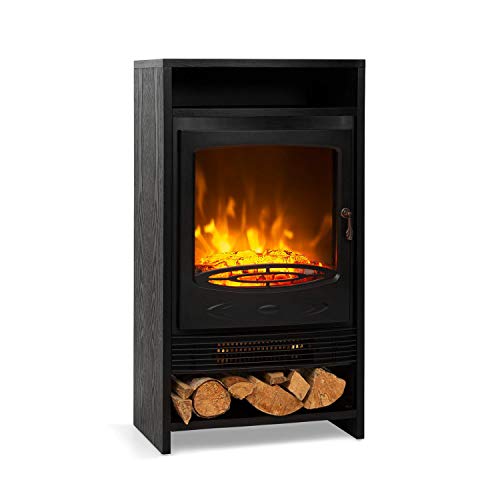Ethanol fireplaces are great for adding a warm and cozy atmosphere to any room without the need for costly structural work or gas supply. They are the safest fire type available.
 As long as you use bio-ethanol fuel that has been specifically formulated for your fire and you follow the safety guidelines, your fireplace should be very safe to operate.
As long as you use bio-ethanol fuel that has been specifically formulated for your fire and you follow the safety guidelines, your fireplace should be very safe to operate.Installation is simple
Ethanol fires are a simple and simple solution for homeowners who want to make their living spaces more attractive or add a focal point to their home decor. You don't require a chimney and they don’t emit dangerous smoke. Soot won't accumulate on your walls or ceilings.
If you decide to go with a full fire suite - such as Mano Mano's Adam Solus Fireplace Suite in Oak with Colorado Bio Ethanol Fire in Black from PS569 - or a freestanding model that can be moved from room to room (such as the Planika Petit, PS191) Installation is easy and does not require any assistance from a specialist. All you have to do is ensure that the ceiling or wall is sturdy enough and follow the instructions for the specific model.
If you opt for an ethanol fireplace mounted on the wall, most are supplied with the necessary hardware to allow them to be hung like a flat-screen TV, or recessed into the wall. You'll need to find the studs and fit the brackets and extensions however, it will not take more than one hour for professionals to do it.
You can also choose between manual and automatic bioethanol burning devices. The automated burner is designed to keep the fuel away from the flames so it can burn for longer without the risk of overheating or running out. A manual burner works similarly to an old-fashioned fireplace, but you'll need matches or lighters to light the flames.
When choosing a burner for your bio ethanol fireplace, it is important to remember that the burner should be covered by non-combustible material to make sure that nothing gets in contact with the burning fuel. If you don't cover your burner, it could cause the fire to overheat. This could cause damage to the fireplace.
Ethanol fires are a great option for people who want to create a dramatic feature in their home, but don't have the money or time to install a wood or gas fireplace. These are ideal for new construction and renovations in which chimney breasts were removed. Since they don't produce soot or ash, there aren't any issues with maintenance or worry about.
Designs and styles
Bio ethanol fireplaces come in different styles and designs. Some have a more traditional wood-burning fireplace look, while others are designed to be modern and sleek. Each model has the same benefits, regardless of style that is a genuine flame atmosphere without toxic fumes or smoke.
Ethanol fires can be mounted on the wall or freestanding. Freestanding models can be moved around the room to suit your needs. Wall-mounted models on the other hand, are anchored to the wall and may require special mounting equipment. They also have to meet certain clearance distances from flammable substances.
The fire is started by a burner pan located on the bottom of the fireplace. Fuel is poured into the pan and the fire is lit with a long-lasting lighter. It takes about 15 minutes for the flames to reach their full potential. Once the fire is lit, you can sit back and relax in the warm and cozy atmosphere of your home.
Some ethanol fire places have heating settings that can be adjusted. This lets you customize the amount of heat that your fireplace produces, which can be beneficial if you wish to provide more warmth than just ambience.
A further benefit of ethanol fires is that there is no need for a chimney or flue. This makes them an excellent option for homes that are new or older homes that do not have traditional fireplaces or chimney breasts. Bio-ethanol fires do not release harmful gasses or ash, which can be harmful to those suffering from respiratory ailments.
Installing bioethanol fireplaces into your home is also easy. The exact installation time will depend on the model that you choose. However, most models can be installed quickly. You can opt for a portable freestanding fireplace that can be taken with you if ever you decide to move. This is a great option for living arrangements that are temporary. It is crucial to think about the ease of installation when purchasing the fireplace.
No flu
The big advantage that bio ethanol fires have over traditional gas or wood fires is that they don't require a flue to operate. As a result, there's no chance of chimney fires which could be caused by the build-up of tar, or obstructions in the flue.
A bio ethanol fireplace doesn't create a lot of particles that could harm the air quality, which is great news for those suffering from asthma or allergies. The fire doesn't produce smoke, so it does not create a bad odor in the room.
In contrast to a fireplace that burns wood, bio ethanol fires don't lose a lot of heat through the chimney, which means it can produce an incredible amount of heat for its size. This lets you place your furniture in close proximity to the flame without having to worry about it getting caught on fire and causing danger.
There are many designs to choose from for a bio-ethanol freestanding fireplace. You can opt for modern and sleek design by installing it on the wall or choose an recessed model that will blend into the style of your space.
Another thing to consider is whether you'd prefer either a manual or automatic burner. A manual burner requires you to ignite the fuel directly from the reservoir, while an automatic burner will automatically light your fire once the tank is empty.
After you've used your bioethanol fireplace it is important to let the flames burn out completely and to wait until the burner has cooled before refueling. Otherwise, the ethanol will evaporate and you'll need to start over.
Most manufacturers suggest waiting at least 45 minutes before refilling your fire. This gives you enough time to safely extinguish the flames, and to remove any flammable materials from the fire. To prevent accidents, keep any spare ethanol fuel away from the reach of pets and children.
Maintenance ease
The bioethanol fuel is put into the burner and then ignited. The heat and flame produced by the burning fuel can be controlled with the slider. (Not all models have this feature). By altering the amount of oxygen that is fed to the fire, you can adjust how quickly the fuel is burned and the intensity of the flame.
The soot that is produced from the combustion of fuel is easily removed using a the help of a soft, clean cloth. The only other thing to do is to keep the burner topped up with the right fuel and ensure that it's not in contact with flammable materials or objects.
 Another advantage of bio ethanol fires is that you can put them almost anywhere without having to worry about chimneys or building regulations. This allows you to be very flexible in designing your home, and where you want to sit and enjoy the warmth of your fireplace. You can even opt for a freestanding fireplace that can be moved.
Another advantage of bio ethanol fires is that you can put them almost anywhere without having to worry about chimneys or building regulations. This allows you to be very flexible in designing your home, and where you want to sit and enjoy the warmth of your fireplace. You can even opt for a freestanding fireplace that can be moved.Wall-mounted bioethanol fireplaces can be fitted into your wall with ease, and some models can be rotated by 180 degrees, allowing you to focus the heat and flame to the desired location of your living space. You can also mount remote controls on some models to control the entire thing from the comfortable sofa.
To maximize versatility, a lot of the plug and play' wall-mounted bioethanol fireplaces have brackets that let you attach them to a flat or sloping ceiling. This allows you to place the fireplace wherever you want it and still be capable of turning the flame off or on and alter the flame's height, and set the temperature using the remote control.
When you're not using the ethanol fireplace, make sure to shut it off and keep it clear from any flammable objects or materials. Also, don't pour additional fuel inside the burner until it's cooled to room temperature. Always be cautious when handling the burner since it will be very hot.



